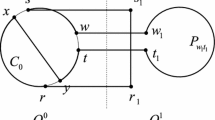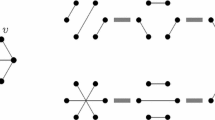Abstract
If every perfect matching of a graph G extends to a Hamiltonian cycle, we shall say that G has the PMH-property—a concept first studied in the 1970s by Las Vergnas and Häggkvist. A pairing of a graph G is a perfect matching of the complete graph having the same vertex set as G. A somewhat stronger property than the PMH-property is the following. A graph G has the PH-property if every pairing of G can be extended to a Hamiltonian cycle of the underlying complete graph using only edges from G. The name for the latter property was coined in 2015 by Alahmadi et al.; however, this was not the first time this property was studied. In 2007, Fink proved that every n-dimensional hypercube, for \(n\ge 2\), has the PH-property. After characterising all the cubic graphs having the PH-property, Alahmadi et al. attempt to characterise all 4-regular graphs having the same property by posing the following problem: for which values of p and q does the Cartesian product \(C_p\square C_q\) of two cycles on p and q vertices have the PH-property? We here show that this only happens when both p and q are equal to four, namely for \(C_{4}\square C_{4}\), the 4-dimensional hypercube. For all other values, we show that \(C_{p}\square C_{q}\) does not even admit the PMH-property.


Similar content being viewed by others
References
M. Abreu, J.B. Gauci, D. Labbate, G. Mazzuoccolo and J.P. Zerafa, Extending perfect matchings to Hamiltonian cycles in line graphs, Electron. J. Combin. 28(1) (2021), #P1.7.
A. Alahmadi, R.E.L. Aldred, A. Alkenani, R. Hijazi, P. Solé and C. Thomassen, Extending a perfect matching to a Hamiltonian cycle, Discrete Math. Theor. Comput. Sci. 17(1) (2015), 241–254.
D. Amar, E. Flandrin and G. Gancarzewicz, A degree condition implying that every matching is contained in a hamiltonian cycle, Discrete Math. 309 (2009), 3703–3713.
J.A. Bondy and U.S.R. Murty, Graph Theory, Springer Series: Graduate Texts in Mathematics 244, 2008.
J. Fink, Perfect matchings extend to Hamilton cycles in hypercubes, J. Combin. Theory Ser. B 97 (2007), 1074–1076.
J.B. Gauci and J.P. Zerafa, On a family of quartic graphs: Hamiltonicity, matchings and isomorphism with circulants, submitted, arXiv:2011.04327.
R. Häggkvist, On \(F\)-Hamiltonian graphs, in: J.A. Bondy, U.S.R. Murty (eds.), Graph Theory and Related Topics, Academic Press, New York, 1979, 219–231.
M. Las Vergnas, Problèmes de couplages et problèmes hamiltoniens en théorie des graphes, Thesis, University of Paris 6, Paris, 1972.
F. Ruskey and C. Savage, Hamilton cycles that extend transposition matchings in Cayley graphs of \(S_{n}\), SIAM J. Discrete Math. 6 (1993), 152–166.
F. Wang and W. Zhao, Matchings Extend to Hamiltonian Cycles in 5-Cube, Discuss. Math. Graph Theory 38 (2018), 217–231.
Z. Yang, On \(F\)-Hamiltonian graphs, Discrete Math. 196 (1999), 281–286.
Author information
Authors and Affiliations
Corresponding author
Additional information
Communicated by Ararat Harutyunyan.
Publisher's Note
Springer Nature remains neutral with regard to jurisdictional claims in published maps and institutional affiliations.
Rights and permissions
About this article
Cite this article
Gauci, J.B., Zerafa, J.P. Perfect Matchings and Hamiltonicity in the Cartesian Product of Cycles. Ann. Comb. 25, 789–796 (2021). https://doi.org/10.1007/s00026-021-00548-1
Received:
Accepted:
Published:
Issue Date:
DOI: https://doi.org/10.1007/s00026-021-00548-1




